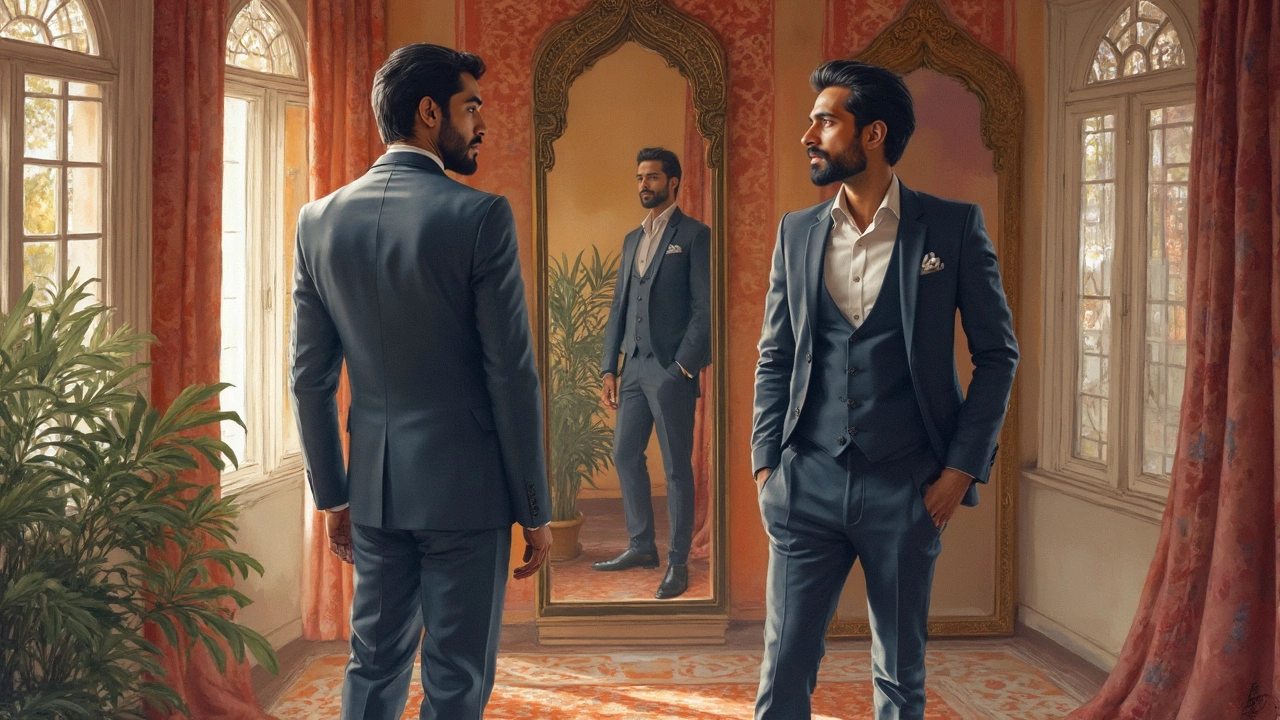Should a Suit Fit Snug or Loose?

Nailing the perfect suit fit isn't just about style; it's also about comfort. So, the big question: tight or loose? If it's too tight, you'll feel like a pretzel. Too loose, and you'll look like you're playing dress-up in dad's clothes. Finding that sweet spot can be a game-changer not just for special occasions but for every day at the office too.
Picture this: A tailor-fit suit that moves with you and highlights the best of your frame without feeling like you're in a straitjacket. That's the aim, right? But how do you get there? First off, know that not all body types are created equal, and neither should suit fits be. Understanding what works for your unique shape means checking off key areas: shoulders, chest, waist, and even the length of your trousers.
Most of us have probably been guilty of buying off-the-rack suits without a second thought. But learning how to spot a suit that's right for your body can rescue you from looking out of place, whether it’s for an interview or a friend's wedding. The good news? With a few tips on measurements and a dash of attention to detail, any guy can sharpen up his suit game without complicating things too much.
- The Importance of Fit
- Finding the Right Balance
- Common Fit Mistakes
- Practical Tips for Measurements
- Style vs. Comfort: Making the Choice
The Importance of Fit
Suits aren't just about fabric and color; the fit is what truly makes or breaks the look. Have you ever noticed the difference in how someone carries themselves when their suit fits like a glove versus when it's just dragging or pulling in weird places? It's a game-changer. A properly fitted suit can elevate your style and boost confidence, while a bad fit can sabotage your whole look.
Let's break it down: Why does it matter if your suit is tight or loose? Well, a suit that hugs your figure without constricting is often seen as more modern and chic, making you look polished and put-together. But if it's too tight, you're not just risking a ripped seam; you're sacrificing comfort, which can make you come across as awkward or stiff.
A loose suit, on the other hand, might feel like you're hiding in a tent. While it offers comfort, it can drown your frame and create a sloppy appearance. There's a reason why tailors are still in business—getting the right balance isn't always achievable straight off the rack.
- Shoulders: The jacket should rest neatly on your shoulders, not sagging and definitely not tight.
- Chest and Waist: Fastening the button should feel snug but not strained; you should be able to fit a hand's breadth between your chest and jacket.
- Sleeve Length: Show a half-inch of shirt cuff for that polished look.
- Trouser Length: A slight break over the shoe is usually a safe bet.
Getting these elements right can help you avoid common pitfalls like button gapping and sleeve bunching. A quick tip from the pros: if it doesn't fit quite right off the shelf, don't shy away from alterations. They can transform an ordinary men's suit into something that looks tailor-made.
Did you know that according to a recent survey, 68% of men wear the wrong suit size? The good news is that knowing what to fix is half the battle. With these insights, you're already on your way to making better choices and looking sharp, whether you're at a job interview or any big event.
Finding the Right Balance
So how do you find that perfect balance between tight and loose suits? It's a bit of a Goldilocks situation: you want something just right. The first step is understanding your body type because that's going to dictate everything.
For starters, if you're on the slimmer side, a more fitted suit will highlight your frame without drowning you. But remember, fitted doesn't mean suffocating. You should be able to move your arms and sit comfortably without feeling like the seams are about to burst. For those on the bulkier side, you want to avoid boxy suits. Instead, look for a cut that gives a bit of structure without clinging unnecessarily.
A few key areas can help you judge if you're striking the right balance:
- Shoulders: This is the backbone of the suit. You want the shoulder seams aligned just where your shoulders end. If they sag or pull, it's a dead giveaway for a bad fit.
- Chest and Waist: Button the jacket and see how it hugs your body. It shouldn't pull at the button, nor should it hang loose. You want a subtle 'V-shape' that flatters the frame.
- Sleeves: The cuff should hit right at the wrist bone, letting about half an inch of shirt show.
- Pants Length: Gone are the days of pooling fabric. The hem of your trousers should have just a slight break. Too long, and it looks sloppy.
Pro tip: When buying a suit, always try it on with a dress shirt to get the full picture.
Now, pure style might push you towards more fitted cuts, but don't sacrifice basic comfort. A UC study—I can't recall the exact journal name but it was about men's fashion—pointed out that too-tight suits can restrict movement, impacting posture over time. So, give a test run: sit, stretch, and move around in the suit. If you're not at ease, it might be time to upsize or consider alterations.
Ultimately, the aim should be a suit that follows the natural curves of your body without being too restrictive. Hit that sweet spot and you'll not only look good, but feel good too. It's all about enhancing your natural build, without making the suit wear you.

Common Fit Mistakes
We’ve all been there, staring at ourselves in the mirror trying to figure out what feels so off about this "perfect" suit. Truth is, common fit mistakes are surprisingly easy to make. Let’s break down what might be going wrong.
One big no-no is the dreaded shoulder divot. If your suit jacket is giving you weird puffs at the shoulders, it's a sign it's too big. The shoulders of a men's suit should hug your own without any excess padding flaring out.
Next up, sleeve length. It's all about the small details here. Sleeves that cover half your hand are too long. Aim for the sleeves to end right at the wrist bone, giving a peek of your shirt cuff.
A suit fit issue that often goes unmentioned is the jacket's length. Imagine a line going from the back of your neck down past your derrière. If the bottom of your coat crosses this line, it’s likely too long, and you could end up looking a bit like a kid in his dad's jacket.
Let’s not forget the pants. Ever seen someone taking painful strides in super tight pants? That's exactly why pants should never be skin-tight. You need room to move and a slight break at the shoe.
- Watch for baggy back pleats on the jacket—they can totally ruin a sharp look.
- Test the chest fit. You should comfortably button the jacket without squeezing yourself into it.
- Don’t ignore the waist fit—it’s crucial for maintaining a sleek profile.
| Common Mistake | Solution |
|---|---|
| Shoulder Divots | Choose a jacket with a snug shoulder fit. |
| Too Long Sleeves | Ensure sleeves end at the wrist bone. |
| Baggy Pants | Select a fit that allows movement without being too tight. |
Seems minor, but avoiding these common fit mistakes can dramatically improve your look and make wearing a suit feel less like a chore and more like channeling your inner James Bond.
Practical Tips for Measurements
When it comes to choosing between a tight or loose suit, measurements are your best friend. A good fitting suit doesn’t require you to sacrifice comfort for style. Thanks to some tried-and-true measures, you can have the best of both worlds!
First things first, grab a flexible measuring tape. If you don't have one handy, your local tailor can always lend a hand. Here are vital points you should measure:
- Shoulders: They’re the backbone of your suit fit. Measure from one shoulder edge to the other, making sure it's straight across your back.
- Chest: Wrap the tape around the fullest part of your chest and under your arms. Keep it snug but not tight—you should be able to slide a finger in there with ease.
- Waist: Position the tape where you wear your pants. Think about comfort here—no one wants to suck in all day!
- Jacket Length: From the top of your shoulder, down the front of your chest. A pro-tip? It should cover your seat for a clean look.
- Inseam: This is from the crotch to the bottom of your ankle. Make sure your trousers have a slight break at the shoe.
These elements go a long way in helping tailor your suit perfectly, whether you're going for a more loose suit style or something tighter and sleek. And remember, comfort should always be a priority.
If you were weighing options, some current data reveal that most men tend to prefer suits that balance between tight and loose, allowing both style and movement. In fact, according to a 2024 Men's Fashion survey, 45% of respondents chose fits labeled as 'tailored' – meaning not too tight, not too loose – as their preferred suit style.
| Fit Type | Percentage |
|---|---|
| Tight Fit | 20% |
| Loose Fit | 35% |
| Tailored Fit | 45% |
These measurements and tips will help you hit the mark every time, whether you're a fan of men's suits for daily wear or special occasions. So next time you're facing the mirror, you'll know your suit's fit isn't just about looks—it's about you, owning your look with confidence.

Style vs. Comfort: Making the Choice
So, you're stuck deciding if you should prioritize style or comfort when it comes to men's suits. Here's the scoop: it doesn't have to be an either-or situation. You can definitely have both, but it helps to know what you're aiming for in various settings.
If it's a job interview or a big meeting, style might take the front seat. First impressions matter, and a sharp suit fit can give you that confident edge. Slim-fit suits are popular for this reason—they offer a sleek appearance that says you mean business. But here's the kicker: slim doesn't mean suffocating. You should still be able to easily shrug on your jacket and button it up without fearing the buttons might pop.
For everyday wear, comfort plays a huge role. No one wants to feel trapped in a suit for hours. A more relaxed fit, like a classic or modern cut, allows you room to breathe while still maintaining a polished look. Just make sure it doesn’t verge on baggy; you’re aiming for comfortable, not sloppy.
Suit fit isn’t entirely subjective. A survey by the International Fashion Institute in 2023 found that 65% of men opted for a mix of modern and slim cuts, balancing both style and comfort. This trend makes sense—people want to look good without compromising the feel-good factor.
Here's a quick checklist to help with your decision-making:
- Assess the occasion: Focus on style for formal events, but keep comfort in mind for day-to-day wear.
- Consider the weather: Lightweight fabrics can offer comfort while maintaining a tailored fit.
- Remember your activities: If you’re moving around a lot, a looser fit at the shoulders and chest will be your friend.
Bottom line, when it comes to the eternal debate of style versus comfort in suits, the best choice fits both your body and your personal style. With a bit of trial and error, you'll find a balance that's just right for you.